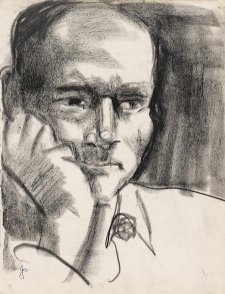Roi de Mestre (later Roy de Maistre) CBE (1894-1968), painter, was a pioneer of post-impressionism and cubism in NSW. First exhibiting with Roland Wakelin and Grace Cossington Smith in Sydney in 1916, he became fascinated by the relationship between music and colour, and in 1919 he painted some of the earliest purely abstract art in the world. After some years travelling back and forth between Europe and Australia, in 1930 he settled in London, where he modified his name, concocted a new identity and lived until his death. He was very close to Patrick White, who became a major collector of his work, and Francis Bacon, who was significantly influenced by his style. After several exhibitions in England and a conversion to Catholicism he was commissioned to paint the Stations of the Cross for Westminster Cathedral. He is represented in all major Australian galleries, and the Tate Gallery in London.
Jean Shepeard was an actress and artist who trained at the Royal Academy of Dramatic Art. While sharing a flat with Peggy Ashcroft, she became a member of the Emotionist group of painters, musicians, philosophers, poets and actors. This drawing was probably included in a 1930 exhibition of works by Shepeard, Roi de Mestre and Francis Bacon in Bacon's Queensbury Mews rooms, then described as a 'studio for modern interior decoration'. Contemporary reviewers praised various qualities in her sensitive drawings of heads, while Bacon's and de Mestre's paintings were thought to be mainly intended as ambient decor. Shepeard continued to exhibit her art while performing in major theatres alongside John Gielgud, Anthony Quayle, Sybil Thorndike and many other leading actors, and progressing to a moderately successful film career. Her other drawing subjects included Francis Bacon, JB Priestly, Peggy Ashcroft and Vanessa Bell.
Collection: National Portrait Gallery
Purchased 2002
© Estate of Jean Shepeard



On one level The Companion talks about the most famous and frontline Australians, but on another it tells us about ourselves.



Lauren Dalla examines the life of Australian painter Roy de Maistre and his portrait by Jean Shepeard.



Visit us, learn with us, support us or work with us! Here’s a range of information about planning your visit, our history and more!